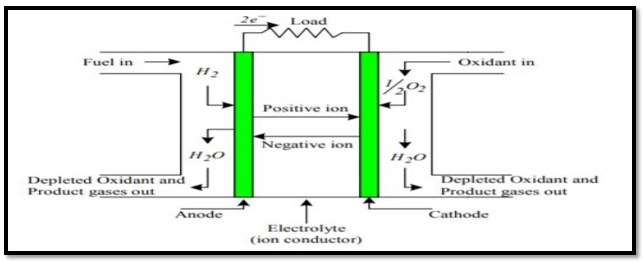Description of the System
The evolution of technology has led to the emergence of unmanned aerial systems (UAS), such as drones and aerial vehicles. One of the leading companies in manufacturing UAS, Ballard, has created two models UAS fueled by hydrogen cell, FCair, with 600 watt and 1200 watt systems (Ballard, 2019). The power difference explains varied functions of FCair as drone and unmanned aerial vehicle (UAV). FCair drone consists of landing support, hydrogen fuel tank on the lower side, power cells on the upper side, and multiple propellers in the middle section.
According to Ballard (2019), hydrogen fuel cell is economical because FCair has a flight time of 90 minutes, which doubles and triples those of drones using an internal combustion engine and batteries, respectively. As shown in Figure 1, the hydrogen fuel cell comprises an anode and a cathode with an electrolyte membrane separating these two electrodes (Manoharan et al., 2019). The function of membrane is to conduct ions nature of membrane used determine the type of the hydrogen fuel cell.

Type of Power Source
The source of power for FCair drone is an electrochemical process because hydrogen reacts with oxygen to generate electrical energy. The hydrogen fuel cell comprises an anode and a cathode with an electrolyte membrane separating these two electrodes (Manoharan et al., 2019). The function of membrane is to conduct ions between electrodes, and its nature determines the type of the hydrogen fuel cell.
The principal mechanism is that hydrogen (fuel) enters into the cell system through anode where it undergoes oxidation to generate proton ions (H+) and two electrons (2e). In contrast, oxygen (oxidant) enters into the cell system via the cathode where it undergoes reduction by gaining 2e to form oxygen anions (O2-) (Yang, Moon, & Kim, 2016). Proton ions and anions create an electrode potential across the membrane, which generates electric power for drone and UAVs. As a by-product, protons and oxygen anions that go through the membrane combine to form water.
Storage of Excess Power
The excess power generated by the hydrogen fuel is stored in lithium batteries. Although hydrogen fuel is highly regulated to generate exact power for Fcair drone or UAV, there is hardly excess power. Ballard (2019) explains that it has designed 600 watt and 1200 watt models of FCair drones. The generated power is sufficient to power drones in normal flight without generating excess energy. However, in some cases, such as taking off and landing, drones require a high level of power. Ballard (2019) reports that lithium batteries are hybridized to the hydrogen fuel system so that it can provide a higher level of power required during vertical take-off and landing. In this view, lithium battery acts as a store for excess power, which supplements high demand during times of taking off and landing.
Comparison with Similar Systems
When compared to similar systems, the hydrogen fuel system is the best because it has numerous advantages. Among the power cells, hydrogen fuel system has a high capacity of power when compared to lithium-ion cells and nickel-metal cells (Adamski, 2017). In terms of flight times, the hydrogen fuel system is the most efficient because its flight is three times (90 minutes) that of lithium batteries (30 minutes) and two times that of internal engine combustion (45 minutes) (Ballard, 2019).
The hydrogen fuel system is appropriate for long range of flight and heavy duties. Other advantages of the hydrogen fuel system are that the fuel is cheap, refuelling is easy, and efficiency is favorable at high altitudes (Swider-Lyons, 2016). From the environmental perspective, the hydrogen fuel system is not noisy, uses renewable source of energy that is safe, and waste products do not pollute the environment.
Type of Propulsion
The hydrogen fuel system uses electric propulsion because it generates power through an electrochemical process. Adamski (2017) notes that engine, regulator, propellers, and battery are four primary components of the electric propeller system. The engine, in this case, is the hydrogen fuel cell, which generates electrical energy to power propellers. The electrical power produced requires control by a regulator to ensure that it meets the needs of drones and UAVs (Yang et al., 2016). Once the right amount of power is produced and regulated to ensure consistency, it is directed to motors in propellers.
The modulation of the amount of power that goes into the proper and navigation techniques propels drones. In cases where there is excess of energy, batteries store and use it in demanding circumstances, such as landing and taking off.
Determinants for Power Usage
As one of the propulsion systems of drones and UAVs, the hydrogen fuel cell provides electrical power through an electrochemical process. Since the hydrogen system produces constant power, operational factors of landing and taking off require additional power. In these instances, drones and UAVs derive their additional energy from high-discharge lithium batteries (Ballard, 2019). However, in maneuvering, the hydrogen fuel system provides adequate energy. As an environmental factor, altitude influences the amount of oxygen available for oxidation in the hydrogen fuel cell. Adamski (2017) holds that high altitudes reduce the efficiency of the hydrogen fuel system due to excessive consumption of energy during propulsion and decreasing concentration of oxygen. Therefore, the demand and the amount of oxygen in air determines the usage of the hydrogen fuel system in the production of power.
References
Adamski, M. (2017). Analysis of propulsion systems of unmanned aerial vehicles. Journal of Marine Engineering & Technology, 16(4), 291-297. Web.
Ballard. (2019). The complete hydrogen solution for commercial UAVs. Web.
Manoharan, Y., Hosseini, S. E., Butler, B., Alzhahrani, H., Senior, B. T., Ashuri, T., & Krohn, J. (2019). Hydrogen fuel cell vehicles: Current status and future prospect. Applied Science, 9(11), 1-17. Web.
Swider-Lyons, K. (2016). Hydrogen fuel cells for small unmanned air vehicles. United States Department of Energy. Web.
Yang, C., Moon, S. & Kim, Y. (2016). A fuel cell/battery hybrid power system for an unmanned aerial vehicle. Journal of Mechanical Science and Technology, 30(5), 2375-2385. Web.